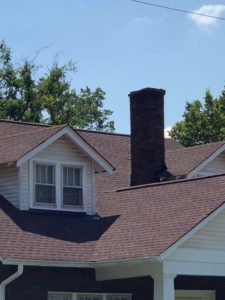Fall is the time to begin thinking about your fireplace, and protecting your chimney from all types of winter damage. At New Buck Chimney Services, the most common winter damage we find and repair is water damage. It’s usually caused by a simple, preventable water leak, and the water damages your masonry from the inside out.
Chimney Leak Symptoms
By the time the average homeowner notices signs of a leak, there can be devastating damage hidden inside the chimney system. Learn the signs of a chimney leak and mark changes in your chimney.
- Dripping sounds in the fireplace or chimney not only means there is water in the chimney but is likely pooling somewhere inside.
- White stains on the chimney exterior. This indicates that water has moved through the masonry, leaving minerals on the outside.
- A leaky ceiling in any part of your house is most likely a leaky chimney. The water enters by way of the chimney, then moves through floors and walls in the house. It pools at the lowest possible spot, then forms a leak. If you have a leak, and you have a chimney, your first call should be a chimney sweep.
- Mildew/moldy odors coming from your chimney, fireplace, or stove means there is water in the chimney, and it’s growing mold.
- Green tinted masonry inside the firebox. Moisture and mold will cause green growth on the bricks that gives them a green tint.
Causes
The most common cause of a chimney leak is a missing or damaged part of the chimney system. When homeowners neglect routine maintenance, it is easy to overlook a missing chimney cap, or shifted bit of flashing. This is why it’s vital to schedule routine maintenance with a certified professional.
- Missing or Damaged Chimney Cap
The cap is the cover that keeps water, wind, and animals out of the flue. Without the cap, whatever falls from the sky or creeps onto your roof can go right into your chimney flue. - Missing or Damaged Chimney Crown
The crown covers the rest of the chimney, from the flue liner to the edge of the chimney. It should be designed with a slight slope so that water runs off, and should have an overhang so that water falls onto the roof instead of the masonry. Crowns should be assessed annually so that they can be sealed if cracks or damage is present. - Missing or Improperly Installed Flashing
Flashing requires a great deal of knowledge for proper placement. The slope, roofing material, and climate all play a part in how the thin layers of metal are placed to prevent water from penetrating it. The flashing is placed at the intersection of the roof and chimney–the most vulnerable part of the whole system. - Damaged Masonry
When a chimney is not properly maintained, water damage can cause masonry gaps and spalling. Natural occurrences like earthquakes and tornados can also cause masonry to shift and crack. When even a slight crack occurs, a leak can happen.
New Buck Chimney Services can fix your chimney leak. We don’t only repair the damage, but we solve the problem. Call new Buck Chimney Services and have your masonry professionally waterproofed for good measure.

